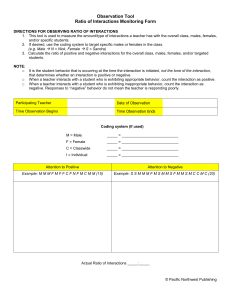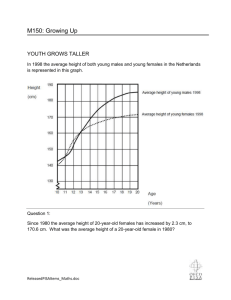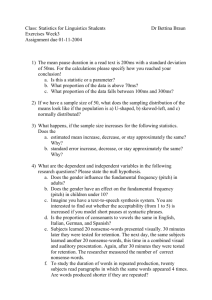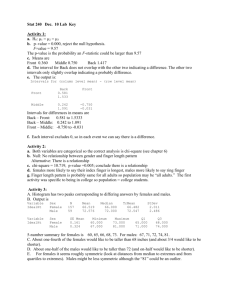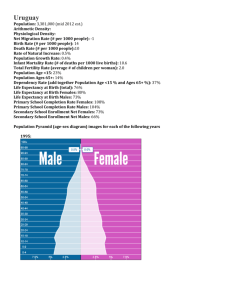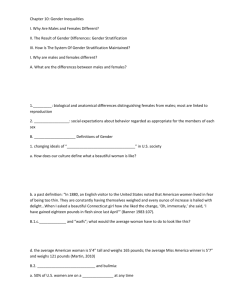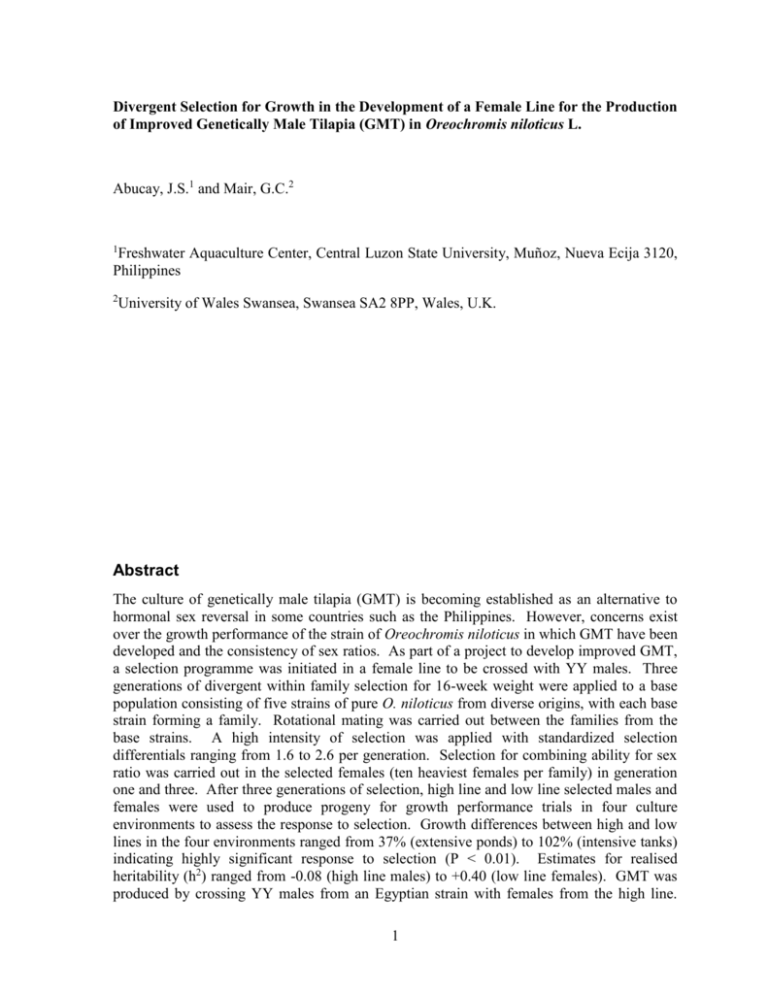
Divergent Selection for Growth in the Development of a Female Line for the Production
of Improved Genetically Male Tilapia (GMT) in Oreochromis niloticus L.
Abucay, J.S.1 and Mair, G.C.2
1
Freshwater Aquaculture Center, Central Luzon State University, Muñoz, Nueva Ecija 3120,
Philippines
2
University of Wales Swansea, Swansea SA2 8PP, Wales, U.K.
Abstract
The culture of genetically male tilapia (GMT) is becoming established as an alternative to
hormonal sex reversal in some countries such as the Philippines. However, concerns exist
over the growth performance of the strain of Oreochromis niloticus in which GMT have been
developed and the consistency of sex ratios. As part of a project to develop improved GMT,
a selection programme was initiated in a female line to be crossed with YY males. Three
generations of divergent within family selection for 16-week weight were applied to a base
population consisting of five strains of pure O. niloticus from diverse origins, with each base
strain forming a family. Rotational mating was carried out between the families from the
base strains. A high intensity of selection was applied with standardized selection
differentials ranging from 1.6 to 2.6 per generation. Selection for combining ability for sex
ratio was carried out in the selected females (ten heaviest females per family) in generation
one and three. After three generations of selection, high line and low line selected males and
females were used to produce progeny for growth performance trials in four culture
environments to assess the response to selection. Growth differences between high and low
lines in the four environments ranged from 37% (extensive ponds) to 102% (intensive tanks)
indicating highly significant response to selection (P < 0.01). Estimates for realised
heritability (h2) ranged from -0.08 (high line males) to +0.40 (low line females). GMT was
produced by crossing YY males from an Egyptian strain with females from the high line.
1
The mean sex ratio of GMT using this selected female line was 97.4% male and preliminary
data from growth trials indicate significant increases in growth rate of this improved GMT
compared to the original inter-strain GMT.
Introduction
The desirability of culturing monosex male populations of tilapia has been long established
as a means to control unwanted reproduction and to exploit the relatively faster growth of
males. Monosex male populations can be produced in a number of ways, most commonly by
direct hormonal sex reversal through the oral application of androgens to sexually
undifferentiated fry. The YY male technology was developed in response to certain
constraints to the commercial scale application of hormonal sex reversal and exploits the
genetic basis of sex determination in Oreochromis niloticus, which is considered to be
predominantly monofactorial (Mair et al., 1991). Mair et al., (1997a) demonstrated the
viability of a breeding programme for the mass production of genetically male tilapia (GMT)
and growth trials revealed the superior growth rate, survival and yield of GMT compared to
mixed sex and hormonally sex reversed tilapia (Mair et al., 1995). The YY male technology
has been adopted commercially by farmers in a number of countries, with widespread
adoption in the Philippines and Thailand. Application of the technology is through the
provision of males from a true breeding YY male line (utilising sex reversed YY females)
and females from a true breeding female line (utilising sex reversed XX males) within the
same strain.
Whilst sex determination is considered predominantly monofactorial following the sex
chromosome model with heterogametic XY males and homogametic XX females, other
factors are known to influence sex ratio. Studies have demonstrated that environmental
factors, notably temperature, can influence sex ratio (Abucay et al., 1999, Baroiller et al.,
1996) but it is also likely that autosomal sex modifying genes play a role in producing sex
ratios deviating from expectation (Mair et al., 1991; Mair et al., 1997a). Mean sex ratios of
GMT in the strain in which it has been developed (known in the Philippines as EgyptSwansea) range from 95-98% but individual family sex ratios can be highly variable. Sex
ratios of crossbred GMT using YY males from the Egypt-Swansea strain with females from
other strains produces more variable sex ratios with lower mean proportions of males (Mair
et al., 1997b and unpublished data). Thus an important consideration in the development of
improved GMT is to minimize variability in sex ratio and maximize the proportion of males.
Assuming a significant role of autosomal sex modifying genes in the occurrence of sex ratios
deviating from expectations, it should be possible to select against such genes by selecting
for the highest proportions of males in progeny of females crossed with YY males. Lester et
al., (1989) estimated heritability of sex ratio of 0.26 in experiments with a Philippine strain
of Nile tilapia.
The YY male technology was originally researched and developed in a domesticated strain of
O. niloticus originating from Lake Manzala in Egypt. Commercial scale production
originated from a stock introduced into the Philippines from the U.K. This stock is likely to
have passed through a number of genetic bottlenecks associated with the transfer and
establishment of U.K. laboratory populations and with the development of the YY male and
all-female broodstock lines. It is thus likely that inbreeding may be affecting the fitness of
2
commercially produced intra-strain GMT and depressing growth rates. This hypothesis is
supported by the superior growth rate exhibited by crossbred GMT using females from
several different strains (Mair et al., 1997b and unpublished data) indicating the presence of
heterosis that might be expected if the parental lines were inbred. To counteract the potential
problem of inbreeding and to develop GMT with superior growth performance, a selection
programme was initiated in a synthetic line of tilapia with the ultimate objective of using this
line in crosses with YY male to produce improved GMT.
The results from selection programmes in tilapia have been quite varied. An early attempt to
apply mass selection for growth rate in an Israeli cultured strain (Hulata et al., 1986) was not
successful with no response detected after two generations compared to unselected controls.
However, a significant but asymmetric response was detected in divergent selection for
growth rate in O. aureus (Bondari et al., 1983). Since these early experiments, there have
been a number of successful selection programmes for tilapia, the most notable being
ICLARM’s GIFT project. Under this large-scale project, six generations of selection for
growth performance were carried out on a synthetic base population created from eight
distinct strains of Nile tilapia. Average response to selection was 13.2% per generation with
estimated realised heritabilities ranging from 0.07 to 0.25 (Eknath and Acosta, 1998). This
level of response and moderate heritabilities indicate that selection is well worthwhile. A
number of other studies have selected tilapia for growth with varying levels of success. A
within family selection programme has produced significant production gains over 13
generations although analysis after eight generations indicated an average response
equivalent to 3% per generation (Bolivar et al., 1994 and unpublished data). Uraiwan and
Doyle, (1986) reviewed data related to different methods of selection for tilapia in Thailand
and concluded that within family selection was likely to be more appropriate for small to
medium scale selection programmes in the region.
Based on past results from previously conducted selection programmes and on the
assumption that adequate genetic variation exists in the five base strains used to form the
selected lines in our study, it was decided to practice within family selection for growth rate
with a high selection intensity. Long term concerns over accumulation of inbreeding were
not of primary consideration due to the fact that the strain was ultimately being selected for a
crossbreeding programme (i.e. for combining ability in crosses with YY males). To
maximise the prospect of detecting response to selection in the shortest time and to best
utilise limited resources (in terms of facilities and manpower) it was further decided to
practice only divergent selection, without an unselected control, which would have been
difficult to maintain over the medium to long term without bias.
This paper reports the preliminary results from the evaluation of growth performance
following three generations of divergent selection for growth rate.
Materials and Methods
The strains were selected as the base for this selection programme on the basis of
comparative growth performance trials under mixed sex and monosex male environments
(Capili, 1995). The strains selected predominantly based on their relative ranking for relative
growth performance in communally stocked trials of mixed sex tilapia.
3
The base strains
The strains, described using nomenclature adopted in the Philippines to label strains of tilapia
being held in live gene banks at the Freshwater Aquaculture Center (FAC), of Central Luzon
State University) on which this selection programme was based were chosen based on results
from comprehensive growth trials conducted by Capili (1995). The following five strains
were used in the first generation of rotational mating:
Egypt-ICLARM (1): This strain was collected by ICLARM as one of the base strains for the
development of the GIFT fish with 30 individuals being collected from three different
locations in Egypt (Eknath et al., 1993). The fish obtained by FAC were the result of a
single pair mating in this strain. Growth trials of multiple strains of tilapia showed this strain
to have superior growth rates to the majority of wild caught and domesticated strains of
diverse origin.
Egypt-AIT (2): This strain originated in Egypt and was transferred to Thailand via Japan.
Stock (50 individuals) was transferred to the Philippines from the Asian Institute of
Technology in 1991. Common with most strains of Egyptian origin, this strain showed
superior growth rates in communally stocked comparisons of 11 strains of tilapia (Capili,
1995).
Kenya-Turkana (3): This strain originated from Crater Lake A in Lake Turkana, Kenya and
with high levels of genetic variation, may represent a sub-species O. n vulcani (Macaranas et
al., 1993). Twenty fish were transferred to the University of Wales Swansea in 1991 and a
pooled spawning of these fish provided fry for transfer to the Philippines. Whilst the relative
growth performance of this strain compared to others in a mixed sex environment was poor
we felt that the high levels of genetic variation seen from allozyme studies (Macaranas et al.,
1993) indicated this would be a good base strain for a selection programme. Furthermore
(Capili, 1995) demonstrated that Kenyan strains have high levels of sexual dimorphism and
have relatively superior performance in all male environments
Kenya-Baringo (4): This strain originates from Lake Baringo in Kenya and is claimed by
(Trewavas, 1983) to represent another sub-species O. n. baringoensis. It was first collected
in 1975 with a supplementary collection in 1982 with stock transferred to Baobab farm in
Kenya. Samples were transferred from there to the University of Wales Swansea in 1987
with progeny from a pooled spawning of several males and females transferred to the
Philippines in 1991. The rationale for choosing this strain is similar to those stated for
Kenya-Turkana.
BFAR strain (5): This strain is considered to be a genetically variable stock compared to
other strains existing in the Philippines although its genetic composition is not documented.
The strain is one that the Philippine Bureau of Fisheries and Aquatic Resources disseminates
to government institutions and the private sector under a national breeding programme
developed in collaboration with ICLARM.
4
The rotational mating scheme
The breeding programme was initiated by first selecting for combining ability for sex ratio.
Twenty females were randomly selected from stock of each strain and stocked for progeny
testing with YY males of the Egypt-Swansea strain. The female from each strain that
produced the highest proportion of males in these progeny tests (100% male in all cases)
were selected. These females were then crossed with randomly selected males from one of
the other strains (male from Strain 1 with female from Strain 2 etc.) in the first round of
rotational mating to produce the first families grown on within family selection. In the
second generation the male from Family 1 were crossed with female from Family 3 and
similarly for all the families. The selected male from Family 1 was crossed with selected
female from Family 4 in the third generation.
The selection procedure
Two selected lines were developed from the progeny resulting from the first rotational
mating, a high line and a low line selecting for the fastest and slowest growth rate
respectively, with five families in each line. With each pair mating of selected males and
females 300 fry (newly swimming fry) from each pair in each strain/family were randomly
selected for on growing. These 300 fry were reared in 150 cm diameter concrete tanks until
they attained an average weight of 0.5 g. At this stage the number was reduced to 100 by
selecting the individual fish with weights closest to the mean (collimation). The remaining
100 fingerlings were then on grown for a further 16 weeks in the same tank. Tanks were
used for the grow-out phases due to the logistical and resource constraints of growing on
numerous families in alternative environments such as earthen ponds, which might have been
preferable environments, being more representative of typical aquaculture environments in
the Philippines. During the grow-out period the fish (beginning at fry stage) were fed ad
libitum with commercially available tilapia diets, starting with fry mash and later with
crumble and pellet form. After 16 weeks, all the fish in each group were individually
weighed and the biggest six males and ten females in each group in high line and the smallest
six males and ten females in the low line were selected. All the selected fish were then PIT
tagged for identification.
At the first selection (i.e. after grow out of five inter-strain crosses) in concrete tanks, the
separate high and low lines were created. Within each family the biggest and smallest males
and females were selected to constitute the high line and low line, respectively. After this
point two lines, with five families per line, were maintained separately following the same
selection procedure outlined above. Initial attempts were made to keep the production of
each selected generation of each family and of each line synchronized. However, this did not
prove possible due to the different times of spawning of the individual selected females in
each line and also due to the much slower growth rates in the low line which resulted in
delayed sexual maturation in the selected females. As a result the two lines came out of
synchrony by up to six months. Families within each line were produced within a period of
two months.
Realised heritability was estimated based on regression of response against cumulative
selection differential according to Falconer and Mackay, (1996).
5
Selection for sex ratio (in progeny tests with YY males) was carried out in the selection of
females for the initial crosses, as described above. Sex ratio selection was also carried out in
the combination with the first and third generation of within family selection for growth in
the high line only. After selecting the biggest six males and ten females, the selected females
were progeny tested by crossing to YY males to determine which females produce the
highest percent males in progeny (with sample sizes in excess of 50). It was not feasible to
select for sex ratio in the low line due to shortage of time. It was also not of commercial
importance to select for sex ratio in this line as it served only as a control. As a result, the
females selected in the high line were not necessarily the heaviest reducing slightly the
selection differential in this line compared to the low line.
It was also not feasible to select males in the high line families for sex ratio due to the
shortage of XY or YY females in the Egypt-Swansea strain that would be required for the
progeny testing. No selection for sex ratio was carried out in the second generation to hasten
the selection for growth rate.
Growth evaluations after three generations of selection
After three generations of selection for growth rate and two generations of selection for sex
ratio, growth evaluation trials were carried out to determine the cumulative response to
selection. The ten biggest females and six biggest males in each family in the high line and
the ten lightest females and six lightest males fish in each family in the low line (i.e. the
preliminary fourth generation selected fish) were pooled, within lines, to produce progeny for
growth evaluations using rotational mating between the families. Similar aged progeny from
these crosses were pooled to provide the mixed sex fish for growth trials. These fish were
nursed separately up to the age and size (approximately 5g) at which they could be marked
by clipping of one of the paired fins (pectoral or pelvic). After marking, the fish were
stocked in four different on-station environments at FAC as follows:
Earthen ponds (200 m²): High and low selected fish were stocked communally with the
“original” intra strain GMT stocked as an internal reference control. Fish were stocked at
three fish per m². Ponds were fertilized with organic and inorganic fertilizers for the first two
months and were fed at 3% of biomass daily, with a commercially available pelleted diet up
to harvest. Three replicate ponds were stocked.
Circular concrete tanks (1.5 m diameter): This represented the environment in which the
fish were selected. Three replicates tanks were stocked for the high and low line fish with 60
fingerlings stocked per tank. Fish were fed twice a day with standard rates of commercially
available tilapia feeds based on 5% biomass of fish in each tank. All the fish were sampled
every two weeks to adjust feeding rates. Continuous flow of clean water was maintained at a
rate of approximately one liter per minute.
Cages in pond (4 m²): Three replicates cages were stocked for the high and low line fish
with 60 fingerlings stocked per cage. Fish were fed twice a day with standard rates of
commercially available tilapia feeds based on 5% biomass of fish in each cage. All the fish
were sampled every two weeks to adjust feeding rates.
6
Intensive circular tank (8 m diameter): This represented an intensive culture system with
high line, low line and “original” intra-strain GMT stocked communally in a single 8 m
diameter concrete tank with continuous water flow and aeration. A total of 6,000 fingerlings
(plus 10% allowance for mortality) were stocked per tank with 1,839 high line, 2,006 low
line and 2,919 GMT. The minor differences in stocking number were due to limited
availability of genotypes of some fingerlings. The stocked fish were fed ad libitum with a
commercially available floating pellet.
Analysis of variance on harvest weight was used to determine growth differences between
strains within each environment. Chi-square contingency tests were used to compare sex
ratios.
A similar set of trials, which will be reported in full elsewhere (Abucay and Mair, in
preparation), were established to compare the growth performance of GMT produced by
crossing females from the selected high line with YY males from the Egypt-Swansea strain
with alternative GMT genotypes.
Results
Selection for sex ratio
Table 1 summarises the data from progeny testing of females in the base strains, first and
third generation selected families in the high line. Sex ratios, with average sample sizes of
46-80 fish, adequate for estimating sex ratios, were surprisingly high in the progeny testing
of females from the base strains, averaging 97.6% male. Mean sex ratios were lower at
92.2% in the first generation (weight) selected females but higher again in the third
generation (96.9% male).
Table 1 Summary of data on which selection for sex ratio was based in the base
(females from the five strains), first generation and third generation weight selected
females. Sex ratios are derived from crosses of females (from ten females selected based
on weight in first and third generations) with YY males of the Egypt-Swansea strain.
Base population
First generation
Third generation
76
29
39
No. of fry tested
4,639
1,443
6,366
Mean no ( s.d.)
61.04 28.88
46.3 16.8
81.60 27.9
Mean % male s.d.
97.59 5.46
92.21 13.56
96.93 4.76
75.00
55.56
81.42
No. of females tested
Minimum
No data are presently available for sex ratios produced by crosses of low line females with
YY males, which would serve as a control to determine the response to selection for sex
ratio.
7
Selection for growth rate
Table 2 summarises the parameters used in the selection for growth in the five families in the
high and low lines. In general the selection intensities for the males (mean of 2.23 and 1.64
in the high and low lines respectively) were higher than for the females (1.93 and 1.42 in
high and low lines). This differential in the high line can be explained to some extent by the
selection for sex ratio that took place in the females in the first and third generation, in which
case the selected females was not necessarily the largest in the family. Selection indices for
the low line were also lower than those for the high line reflecting the greater extremes of
weight on the heavy side of the weight distribution.
Estimates of heritability based on regression of response on cumulative selection differential
were -0.08 and 0.21 for the high line males and females and 0.30 and 0.40 for the low line
males and females respectively.
Table 2 Mean (from five families) weight, selection differentials and selection indices
(standardized selection differentials) for three generations of high and low within
family selection for 16-week growth in Nile tilapia.
Line/
Generation
Sex
Mean weight
in 5 families (g)
Mean weight of
selected fish (g)
Selection
differential
Selection
intensity
High Line
Generation 1
Male
Female
55.68
34.74
85.74
48.66
30.06
11.11
1.93
1.59
High Line
Generation 2
Male
Female
54.23
40.15
76.66
59.52
2.43
9.37
2.42
2.60
High Line
Generation 3
Male
Female
51.41
41.89
78.55
55.87
7.14
3.99
2.33
1.61
Low Line
Generation 1
Male
Female
55.68
34.71
24.16
20.20
-1.52
-4.54
2.01
1.72
Low Line
Generation 2
Male
Female
43.46
25.96
16.92
12.10
-6.54
-3.86
1.72
1.49
Low Line
Generation 3
Male
Female
38.21
23.30
23.10
14.55
-5.11
-8.74
1.20
1.06
Growth evaluation trials
The growth evaluation trials revealed highly significant differences between the high and low
selected lines in all the environments. The results from the culture performance trials are
summarised in Table 3. The difference in the growth rates of high and low line fish
(expressed as a % of the low line weight gain) was 37% in extensive ponds, 41% in concrete
tanks, 66% in cages- in-ponds and 102% in intensive tanks, all of these differences being
8
Table 3 Summary of data from a series of culture performance trials comparing the
high and low selected lines (mixed sex), following three generations of divergent
selection for growth rate, in four different culture environments (values are given as
means +/- standard deviation; P represents levels of probability at which statistical tests
were significant; ns – not significant).
Culture
environment
Parameters
Earthen pond
Area of pond
(Communal
Stocking no. (fish.)
rearing using
Mean initial wt. P<0.01
three ponds)
Mean wt. gain (F&M) P<0.001
High line
Low line
“Original”
GMT
200 m2
200 m2
200 m2
600/pond
4.80 0.40
600/pond
5.17 0.45
a
600/pond
3.60 0.10 b
a
120.16 8.26 a
93.25 2.15 b
132.65 1.87 a
Mean % survival ns
77.60 3.22
77.50 5.00
73.00 5.77
Mean % male P<0.001
35.00 3.19
47.65 2.09
b
80.22 2.98 c
Mean wt. gain (F) P<0.01
103.57 7.67 a
66.56 3.54 c
82.04 4.98 b
Mean wt. gain (M) P<0.01
151.27 8.07 a
122.60 3.52 b
145.04 1.24 a
a
Small circular
Volume of tank
1 m3
1 m3
Tank
Stocking number
60 fish/tank
60 fish/tank
(Separate
Mean initial wt. ns
6.43 0.06
5.50 0.76
102.10 7.06
a
72.56 4.48 b
rearing with
Mean wt. gain (F&M) P<0.01
three
Mean % survival ns
87.78 4.20
80.00 6.01
replicates)
Mean % male ns
44.29 4.13
45.29 5.39
Mean wt. gain (F) P<0.01
83.37 7.16 a
54.76 3.26 b
Mean wt. gain (M) P<0.01
127.03 3.58 a
94.30 5.18 b
Cage-in
Size of cage
2m x 2m x 1m
2m x 2m x 1m
-Pond
Stocking number
60 fish/cage
60 fish/cage
(Separate
Mean initial wt. ns
6.32 0.11
6.03 0.28
rearing with
Mean wt. gain (F&M) P<0.01
101.22 7.99 a
61.14 4.33 b
three
Mean % survival ns
88.33 1.67
81.11 10.05
replicates)
Mean % male ns
39.04 7.86
42.74 6.86
Mean wt. gain (F) P<0.001
94.78 2.68
53.40 5.24 b
Mean wt. gain (M) P<0.05
111.85 16.95 a
71.70 3.19 b
60 m3
60 m3
a
60 m3
Intensive
Volume of tank
Circular tank
Stocking number (line)
6764 (1839)
6764 (2006)
6764 (2919)
(Communal
Mean initial wt. wt P<0.001
3.91 1.33
3.19 1.55
1.32 0.73 c
rearing using
Mean wt. gain (F&M) P<0.001
one tank
only)
a
b
223.99 84.55 a
118.21 64.62 c
169.38 62.60 b
Mean % survival ns
86.19
68.35
72.80
Mean % male ns
39.50
55.36
Mean wt. gain (F) P<0.001
194.73 62.29
Mean wt. gain (M) P<0.001
268.99 93.98 a
9
a
88.58 45.16
87.39
b
142.01 68.02 b
130.17 49.97 c
175.06 62.22 c
highly significant (P<0.01). The relative differences in weight between the high and low
lines was greater for the females than for the males reflecting the higher levels of heritability
for growth in females. In the two environments in which the “original” GMT were added as
internal reference controls, there were significant differences in initial weight (GMT were
smaller) which may have impacted on the relative growth of these fish in communal stocking
due to size based interactions between the genotypes. In the extensively managed earthen
ponds the mean weight of GMT was not significantly different to the selected high line
despite the significantly higher proportion of males (80% compared to only 35%). In the
case of the intensively managed tanks, the high line had significantly greater weight gain
than the GMT with similar differences in sex ratio. There were no significant differences in
the survival of the genotypes during grow-out in any of the environments. An alternative
rough method for calculation of realised heritability based on standardized selection
responses seen in the growth trials and standardized cumulative selection differentials
produced estimates of h2 ranging from 0.06 to 0.11 in the high line an d0.06 to 0.2 in the low
line with higher levels estimates for female growth.
Figure 1 Grouped bar chart showing relative weight gains of high line, low line and
“original” GMT in culture performance trials, in four different culture environments,
following three generations of divergent selection for growth.
300
High Line
Low line
"Original" GMT
Weight gain (g)
250
200
150
100
50
0
0
1
Ponds
2
3
Tanks
Cages
Environment
10
4
Intensive
5
Discussion and Conclusions
The data reported indicate relative success for this breeding programme, combining within
family selection for growth and selection for combining ability (with YY males) for sex ratio.
Highly significant deviations in growth performance were observed between the high and
low selected lines after three generations of selection, reflecting the high intensity of
selection. Selection response and estimates of realised heritability were similar to those
observed by other authors in comparable programmes (Jarimopas, 1990; Brzeski and Doyle,
1996). Furthermore, estimates of realised heritability were within the ranges observed in the
comprehensive studies conducted under GIFT project, which also utilised a genetically
variable “synthetic” base population comprising several strains (Eknath and Acosta, 1998).
However, from an applied perspective, the lower heritability estimates in the high line
compared to the low line is less encouraging. The lower heritability estimates for the high
line reflects the higher selection differentials in this line due to the longer tails on the heavy
side of weight distributions and may not necessarily reflect a significantly lower response to
up selection. Asymmetric response to divergent selection is common, as observed in channel
catfish by Bondari (1986), for numerous reasons including natural selection, scale-effects,
genetic asymmetry and genes with large effects (Falconer and Mackay, 1996).
Further, the apparent greater response to selection in the females than in males provides less
promise for the use of the selected line as a female line in a crossbreeding programme for
GMT production. Nevertheless, preliminary results of crossbred GMT using the selected
high line as the female parent, crossed to YY males of the Egypt-Swansea strain, show
considerable increases in growth rates compared to the “original” intra-strain GMT (Abucay
and Mair, unpublished data).
GMT sex ratio produced by the high line females in crosses with YY males (97.6% male)
were comparable with sex ratios expected in intra strain crosses using the same YY males
(Mair et al., 1997a). Such proportions of males would be adequate for control of
reproduction in most circumstances of commercial tilapia culture.
In conclusion, this intensive selection programme produced significant positive response to
selection for growth rate, and possibly also for combining ability for GMT sex ratio. From a
practical perspective it would appear to be worth continuing with this programme, both for
production of faster growth mixed sex fish, and particularly, as was originally intended, as a
female line for GMT. With a longer term perspective, significant loss of genetic variation
and inbreeding is likely to occur after further rounds of rotational mating, with high selection
intensity, whereby only a single male and a single female are selected in each family. It is
thus recommended that the programme be modified through inclusion of more families and
the selection and breeding of more males and females per family. Provision of a suitable
control population, such as a heterozygous clone produced using isogenic gynogenetic lines,
would facilitate this as the low line could be discontinued, freeing up resources for expansion
of the high line. It is further recommended that selection of combining ability for GMT sex
ratio be carried out but not necessarily every generation.
11
References
Abucay, J.S., Mair, G.C., Skibinski, D.O.F. & Beardmore, J.A. (1999) Environmental sex
determination: the effect of temperature and salinity on sex ratio in Oreochromis niloticus L.
Aquaculture, 173: 219-234.
Baroiller, J.F., Fostier, A., Caulty, A., Rognon, X. & Jalabert, B. (1996) Effects of high
rearing temperatures on the sex ratio of progeny from sex reversed males of Oreochromis
niloticus. In: The Third International Symposium on Tilapia in Aquaculture (Pullin, R.S.V.,
et al. eds.), pp. 246 - 256. International Center for Living Aquatic Resources Management
(ICLARM), Centre de recherches océanologiques (CRO), Institut francais de recherches
scientifique pour le développment en coopération (ORSTOM), Centre de coopération
internationale en recherche agronomique pour le developpment/ Départment d'élevage et de
médecine vétérinaire (CIRAD-EMVT), Manila, Philippines.
Bolivar, R.B., Bartolome, Z.P. & Newkirk, G.F. (1994) Response to within-family selection
for growth in Nile tilapia (Oreochromis niloticus L.) In: The Third Asian Fisheries Forum
(Chou, L.M., et al. eds.), pp. 548-551. Asian Fisheries Society, Manila, Philippines.
Bondari, K. (1986) Response of channnel catfish to multi-factor and divergent selection of
economic traits. Aquaculture, 57: 163-170.
Bondari, K., Dunham, R.A., Smitherman, R.O., Joyce, J.A. & Castillo, S. (1983) Response to
bidirectional selection for body weight in blue tilapia. In: Proceedings of the International
Symposium on Tilapia in Aquaculture, Nazareth, Israel (Fishelson, L. & Yaron, Z. eds.), pp.
302-312. Tel Aviv University, Tel Aviv, Israel.
Brzeski, V.J. & Doyle, R.W. (1996) A test of an on-farm selection procedure for tilapia
growth in Indonesia In Genetics in Aquaculture V (Doyle, R.W., et al. eds.), pp. 219-230.
Elsevier Science, Amsterdam, Netherlands.
Capili, J.B. (1995) Growth and Sex Determination in the Nile Tilapia, Oreochromis niloticus
(L.). Ph.D. Thesis, University of Wales Swansea, U.K. 271p
Eknath, A.E. and Acosta, B.O. (1998) Genetic Improvement of Farmed Tilapia Project Final Report (1988-1997). International Center for Living Aquatic Resources Management,
Manila, Philippines. 75p
Eknath, A.E., Tayamen, M.M., Palada-deVera, M.S., Danting, J.C., Reyes, R.A., Dionisio,
E.E., Capili, J.B., Bolivar, H.L., Abella, T.A., Circa, A.V., Bentsen, H.B., Gjerde, B.,
Gjedrem, T. & Pullin, R.S.V. (1993) Genetic improvement of farmed tilapias: the growth
performance of eight strains of Oreochromis niloticus tested in different farm environments.
Aquaculture, 111: 171-188.
Falconer, D.S. & Mackay, T.F.C. (1996) Introduction to Quantitative Genetics, Longman,
England. 464p.
12
Hulata, G., Wohlfarth, G.W. & Halevy, A. (1986) Mass selection for growth rate in the Nile
tilapia (Oreochromis niloticus). Aquaculture, 57: 177-184.
Jarimopas, P. (1990) Realized response of Thai red tilapia to 5 generation of size-specific
selection for growth. In: The Second Asian Fisheries Forum (Proceedings of The Second
Asian Fisheries Forum,Tokyo,Japan,17-22 April 1989) (Hirano, R. & Hanyu, I. eds.), pp.
519-522. Asian Fisheries Society, Manila, Philippines.
Lester, L.J., Lawson, K.S., Abella, T.A. & Palada, M.S. (1989) Estimated heritability of sex
ratio and sexual dimorphism in tilapia. Aquaculture and Fisheries Management, 20: 369-380.
Macaranas, J.M., Eknath, A.E., Agustin, L.Q., Velasco, R.R., Ablan, M.C.A. & Pullin,
R.S.V. (1993) Genetic improvement of farmed tilapia: documentation and genetic
characterization of strains In Genetics in Aquaculture IV, Proceedings of the Fourth
International Symposium on Genetics in Aquaculture (Gall, G.A.E. & Chen, H. eds.), pp.
296. Elsevier Science Publishers B. V., Amsterdam, Netherlands.
Mair, G.C., Abucay, J.S., Beardmore, J.A. & Skibinski, D.O.F. (1995) Growth performance
trials of genetically male tilapia (GMT) derived from YY - males in Oreochromis niloticus
L.: On station comparisons with mixed sex and sex reversed male populations. Aquaculture,
137: 313-322.
Mair, G.C., Abucay, J.S., Skibinski, D.O.F., Abella, T.A. & Beardmore, J.A. (1997a) Genetic
manipulation of sex ratio for the large-scale production of all-male tilapia, Oreochromis
niloticus. Canadian Journal of Fisheries and Aquatic Science, 54: 396-404.
Mair, G.C., Scott, A.G., Penman, D.J., Beardmore, J.A. & Skibinski, D.O.F. (1991) Sex
determination in the genus Oreochromis 1. Sex reversal, gynogenesis and triploidy in O.
niloticus (L). Theoretical and Applied Genetics, 82: 144-152.
Mair, G.C., Capili, J.B., Skibinski, D.O.F., Beardmore, J.A., Pascual, L.P., Abucay, J.S.,
Danting, J.C. & Reyes, R.A. (1997b) Sex ratios and growth performance of crossbred
genetically male tilapia using YY males in Oreochromis niloticus L. In Tilapia Aquaculture.
Proceedings from the Fourth International Symposium on Tilapia in Aquaculture
(Fitzsimmons, K. ed.), Vol. 1, pp. 262 - 271. Northeast Regional Agricultural Engineering
Service (NRAES), New York.
Trewavas, E. (1983) Tilapiine fishes of the genera Sarotherodon, Oreochromis and
Danakilia, Trustees of the British Museum, London. 583p
Uraiwan, S. & Doyle, R.W. (1986) Replicate variance and the choice of selection procedures
for tilapia (Oreochromis niloticus) stock improvement in Thailand. Aquaculture, 57: 93-98.
13

